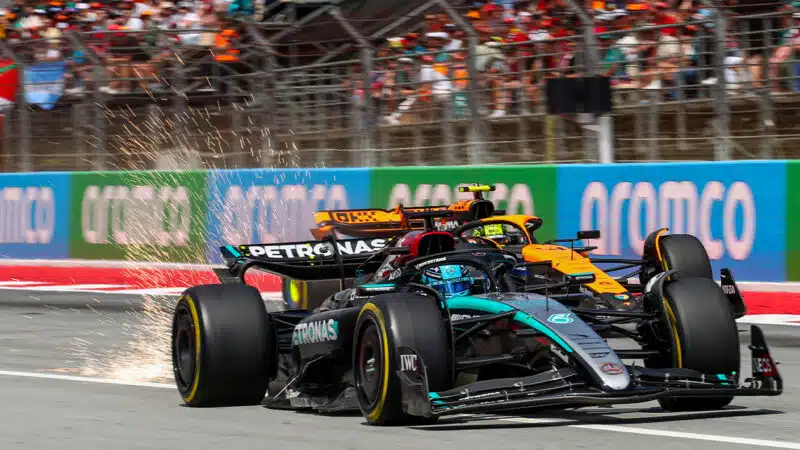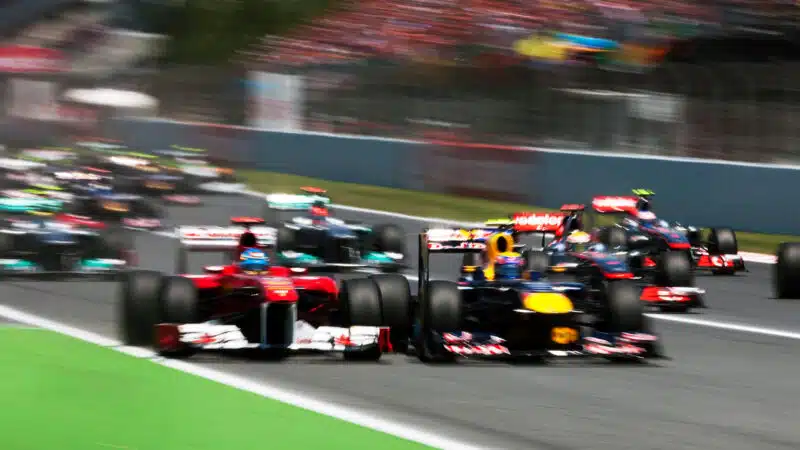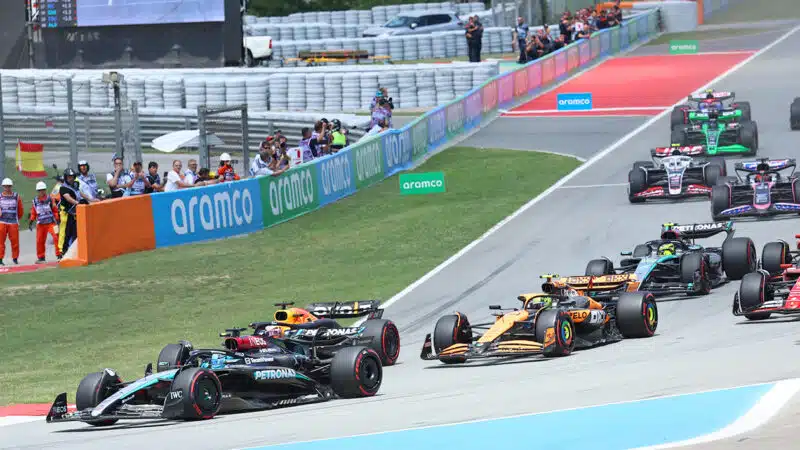How Russell's homework undid Norris's Spanish GP victory hopes in seconds
A split-second difference was all it took for Lando Norris to lose out at the start of the 2024 F1 Spanish Grand Prix, with George Russell prepared to take advantage and the McLaren driver playing catch-up all race

Norris was held back by Russell after losing out at the start
Peter Fox/Getty Images
Compare the getaways of Lando Norris from pole and Max Verstappen from alongside him on the front row and we’re talking fractions of milliseconds difference. It may have been nothing more than the difference in surface grip between the two sides of the Barcelona grid. Verstappen’s initial getaway is calmer, lower-revving but not noticeably faster than Norris’s more flamboyant start. It’s as they move to the second phase of their clutches that they diverge, with the Red Bull making a nice smooth transition in contrast to the McLaren stuttering into wheelspin. Possibly Norris released the second paddle a little too abruptly, maybe it was the rear tyre temperatures. Verstappen had done a double burn-out to his slot, as instructed, Norris just a single one. Maybe it was none of those things. Maybe the Red Bull-Honda software is just more refined.
Whatever that difference was decided which of them — Verstappen — won the Spanish Grand Prix and which (Norris) finished second. Because the outright pace of the two cars was directly comparable even around F1’s most aerodynamically-demanding track. There were differences in how those performances were delivered, but they were far less significant to the outcome than that startline choreography – which crucially involved also George Russell.
He made a flyer from the Verstappen side of the second row (so maybe it was track grip), instantly out-accelerating Mercedes team-mate Lewis Hamilton and then picking up a double tow from the dicing Verstappen and Norris as the McLaren driver leant on the Red Bull over towards the grass on the right-hand side. They were straining against a headwind which Russell sheltered from, first behind Verstappen, then Norris, before finally flicking out around the outside with his greater momentum and taking the lead. George had been studying the starts of this race over the years and had been particularly taken with how Fernando Alonso had pulled off a similar move to lead from row 2 at the start of the 2011 race. So when the opportunity presented itself, it was already in Russell’s mind.
“If George hadn’t been there,” lamented Norris, “I think I could have kept ahead of Max by going around the outside into Turn 1.” But George was there and Norris, as the meat in the sandwich, was forced to concede to avoid contact. Russell, Verstappen, Norris was the order through there.
The Mercedes is improving but it wasn’t a Red Bull or McLaren match around Barcelona. Even with everyone driving to their tyre temperatures. Verstappen attacked from the off and as soon as DRS was enabled after lap 1, he knew what he was going to do, encouraged by his race engineer: using the Red Bull’s great fast corner speed, he’d take the last turn as hard as he dared, with his battery fully charged up. Although he’d been 100% flat through there in qualifying, there was no way that was feasible in race conditions on a full tank of fuel. But nonetheless, he didn’t lift completely on the approach, just a brief lift down to 8% throttle (with everyone else at zero throttle as they lifted), exiting at 236km/h (147mph) (around 3km/h faster than anyone else at that stage) and getting the DRS to make a straightforward pass.

Alonso made use of the double draft to hit the front in Spain, 2011
Getty Images

Russell studied Alonso’s move and employed it to similar effect
Grand Prix Photo
With Russell just driving to his tyre temperatures, Verstappen was able to eke out a small but handy advantage that took him out of undercut threat as the first pitstop window opened up. Norris was not in a position to do what Verstappen had just done. The McLaren wasn’t as quick through that final turn for one thing. For another, he knew his big advantage over Verstappen was going to come towards the end of the stints. So to attack Russell would waste that valuable advantage.
Knowing it was slower than Norris, Mercedes did not wish to run longer and so defended against any undercut by pitting Russell early – on lap 15. That’s when we saw that Norris’s pace at this stage of the race was around 1sec faster than that which Russell had been holding him to. He quickly began closing on Verstappen, so much that Red Bull brought Max in early, on lap 17.
Norris stayed out an extra six laps, but the new-tyred cars (Verstappen, the two Mercs and two Ferraris) had all been lapping faster, such was the high degradation, and so he rejoined behind them all. He’d spend the next 13 laps clawing his way back up to second, with Russell putting up the fiercest defence and thereby costing Norris yet more time.

Polesitter Norris is overhauled at the start
Peter Fox/Getty via Red Bull
By the time he finally cleared the others, Norris was 8sec adrift of Verstappen. He was lapping whole chunks faster though and had the gap down to 5sec, but it was all under control at Red Bull as they came up to the second stops. Max pitted with 18 laps left, pulled out a few seconds of undercut on Norris, who began his charge all over again. He fell short by a couple of seconds.
Hamilton came through for his first podium of the season, able to run long enough in the second stint to get onto the soft tyres at the end, these working so much better than the hards Russell had been obliged to take when pitting seven laps earlier. The Ferraris were on much the same sub-Red Bull/McLaren pace as Mercedes, with Charles Leclerc and Carlos Sainz taking a niggly fifth and sixth. In a no-man’s land seventh Oscar Piastri for the first time just could not get a handle on the McLaren. Sergio Perez in eighth drove a three-stop recovery from a difficult qualifying and grid penalty. Alpine gave itself something to cheer about as Pierre Gasly and Esteban Ocon took the final two points places with both having made Q3 and lapped there within 0.5sec of pole.
